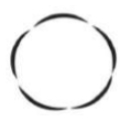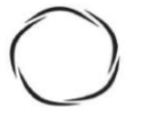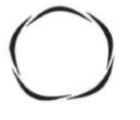The cells of which of the following regions of the root are responsible for growth of its length?
1. Root cap
2. Region of meristematic activity
3. Region of elongation
4. Region of maturation
Identify the correct statement regarding the stem morphology from the following:
| I: | Stems bear only axillary buds. |
| II: | Axillary buds may get modified into thorns as in Citrus |
| III: | Stem tendrils develop from axillary buds as in gourds. |
| 1. | Only I and II | 2. | Only I and III |
| 3. | Only II and III | 4. | I, II and III |
The type of placentation show in the given figure is seen in:
| 1. | Dianthus | 2. | Argemone |
| 3. | China rose | 4. | Marigold |
The given floral diagram can be of:
1. Asparagus
2. Atropa belladonna
3. Mustard
4. Indigofera
Match the columns A and B:
| Column I | Column II | ||
| (a) | Marginal placentation | (i) | Marigold |
| (b) | Axile placentation | (ii) | Dianthus |
| (c) | Parietal placentation | (iii) | Argemone |
| (d) | Free central placentation | (iv) | Chinarose |
| (e) | Basal placentation | (v) | Pea |
| (a) | (b) | (c) | (d) | (e) | |
| 1. | (v) | (iv) | (iii) | (ii) | (i) |
| 2. | (v) | (iii) | (iv) | (i) | (ii) |
| 3. | (iv) | (iii) | (v) | (ii) | (i) |
| 4. | (i) | (v) | (iv) | (iii) | (ii) |
An inferior ovary:
| 1. | is situated on the receptacle above the perianth and androecium. |
| 2. | is positioned below the sites of attachment for perianth and androecium. |
| 3. | forms a hypanthium. |
| 4. | is positioned below the receptacle. |
The type of aestivation seen in Calotropis is represented by:
| 1. |  |
2. |  |
| 3. |  |
4. |  |
The floral diagram shown in the given diagram can be of:
1. A plant that produces a chemical that can disrupt mitotic spindle
2. Deadly night shade
3. Indigofera plant, a source of dye
4. A pulse plant
The region responsible for growth in the length of the root is:
1. A
2. B
3. C
4. D
Match each item in Column I with one item in Column II and chose your answer from the codes given below.
|
Column I (Flower) |
Column II (Position of ovary) |
|
I. Sunflower II. Mustard III Plum |
1. Epigynous 2. Hypogynous 3. Perigynous |
Codes:
I II III
1. 1 2 3
2. 2 3 1
3. 2 1 3
4. 3 2 1










